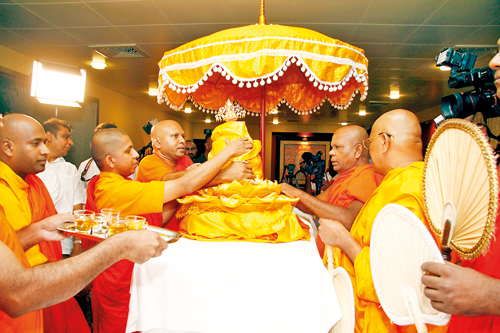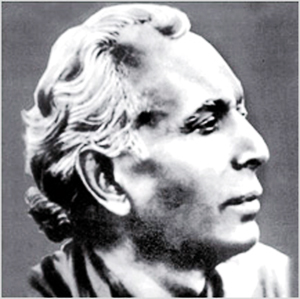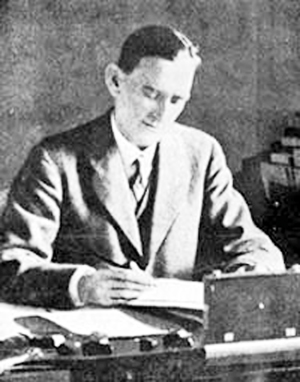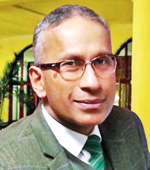Britisher who unearthed Buddha’s relics at Sarnath
 At the founding of the Archaeological Department in Hyderabad in 1914, Anagarika Dharmapala, the Lankan Buddhist revivalist and Founder of the Maha Bodhi Society, paid a fitting tribute to Sir John Marshall, Director-General of the Archaeological Survey of India from 1902 to 1928.
At the founding of the Archaeological Department in Hyderabad in 1914, Anagarika Dharmapala, the Lankan Buddhist revivalist and Founder of the Maha Bodhi Society, paid a fitting tribute to Sir John Marshall, Director-General of the Archaeological Survey of India from 1902 to 1928.
“The Imperial Archaeological Department under the directorate of Sir John Marshall is doing religious work in conserving the ancient buildings in different parts of British India. Sir John Marshall is indefatigable in his labour of love. A classical scholar and archaeologist with a scientific knowledge of architecture, he has been able to do much in restoring the neglected buildings of antiquity in India. Under his supervision the Sanchi Topes are being gradually restored, and excavations are being carried out at ancient Taxila in the Rawalpindi district.”
During his excavations in ancient Taxila between 1913 and 1914, Sir John Marshall unearthed authentic relics of Lord Buddha. The relics which were enshrined at the Mulagandhakuti Vihara in Sarnath, built under the auspices of Anagarika Dharmapala came to be revered relics of the Blessed One. In April this year, the relics from Sarnath found by Sir John Marshall along with the second relic found by A.H. Longhurst of the Archaeological Survey of India in 1929 (in a large stupa at Nagarjunakonda in the Guntur District of the then Madras Presidency and later enshrined at Sarnath), were brought here for public exposition during Vesak. The first exposition of the sacred Sarnath relics here at home, was “yet another manifestation of the shared Buddhist heritage of India and Sri Lanka, which forms a spiritual bond between the two nations”, as India’s High Commissioner Taranjit Singh Sandhu observed. It also marked the sacred relics’ first exposition in Sri Lanka, since they were discovered by British archaeologists in colonial India and handed over to the Maha Bodhi Society of India for custody.
Interestingly, Marshall had worked closely with Anagarika Dharmapala on the design of the Sri Dharma Rajika Vihara in Calcutta. A fund was set up to facilitate the building of the viharaya. In ‘Return to Righteousness — A Collection of Speeches, Essays and Letters of Anagarika Dharmapala’, edited by Ananda Guruge, the Buddhist patriot notes that the design of the viharaya was based on the Ajanta Temple architecture and is “exquisitely done”. Dharmapala further documents in one of his essays: “When the temple is erected, it will be an object of attraction in Calcutta. We have to thank Sir John Marshall for the kind services graciously rendered.”

Exposition of Sarnath relics during Vesak this year and (on right) arrival of the Sarnath relics in Sri Lanka with Indian High Commissioner Taranjit Singh Sandhu paying homage. Pix by Indika Handuwala
The author further notes that the construction of the vihara according to the design will require “at least a lakh of rupees” and fervently hopes that “those who love Lord Buddha will, with a cheerful heart, freely give to the Vihara fund”.
Later, in an article in ‘The Buddhist Annual of Ceylon’ (1921), Dharmapala documents his sentiments: “Thanks of the Maha Bodhi Society are due to Sir John Marshall, Director-General of Archaeology, for the kind-hearted sympathy and inspiring advice given to the General Secretary throughout the construction of the Vihara.”
An alumnus of King’s College, Cambridge, Marshall, before assuming duties as the Director-General of Archaeology in India in 1902, had worked in Greece, South Turkey and Crete. Marshall is credited with modernizing the approach to archaeology in this Asian quarter, by introducing cataloguing and conservation of ancient monuments and artefacts. He also engaged native Indians in excavations in their own land. His excavations in Harappa and Mohenjo-daro (the main cities of the Indus Valley Civilization), Taxila, Sanchi and Sarnath shed new light on the cradle of the Asian Civilization. Marshall who was honoured as a Companion of the Order of the Indian Empire (CIE) in 1910, was knighted in 1915.

Anagarika Dharmapala
The excavations at Taxila which commenced in March 1913 were extensive, lasting 20 years. “One of the reasons of the prolonged and extensive work at the site was Marshall’s desire to unearth as totally as possible an early historic city site to throw light on the day-to-day life of the people,” writes Dilip K. Chakrabarti in his work ‘A History of Indian Archaeology from the beginning to 1947’. The author further observes that “Taxila was also a place where Marshall with his experience in classical archaeology would feel at home”. In the preface of Marshall’s
own report on Taxila in 1951, he notes: “It is upwards of forty years since I visited Taxila and I still remember the thrill I got from the sight of its buried cities. At that time I was a young man, fresh from archaeological excavations in Greece and filled with enthusiasm for anything Greek; and in that far-off corner of the Panjab it seemed as if I had lighted all of a sudden on a bit of Greece itself. Doubtless the illusion was prompted in large measure by Taxila’s historic associations with Greece, for it was in Taxila that Alexander the Great halted and refreshed his army before advancing to do battle with Porus.”
It is a little known fact that Marshall visited Sri Lanka in 1917 to present a relic casket excavated from a stupa in Taxila, to the Buddhists of the island as a gift from the Indian Government. The exposition of Sarnath relics (excavated from Taxila but enshrined in the Sarnath viharaya), a century later here at home, early this year, seemed to be a symbolic reminder of the goodwill extended by him towards Buddhists across the world.

Sir John Marshall
The Times of Ceylon (February 2, 1917) which gives an account of Marshall’s arrival in Kandy together with Lady Marshall on February 1, 1917 notes that the couple had stayed at the ‘Old Palace’ and visited the Maligawa. The February 3 edition of the newspaper provides an elaborate description of the presentation of the relics which took place in the Audience Hall or the Magul Maduwa. “A pretty archway had been put up just at the entrance to the Hall and every detail had been attended to,” it says. The crowds which thronged the temple precincts “presented a scene of animation”.
The relic, according to the account, had been accepted by the Diyawadana Nilame, P.B. Nugawela. Later, the relic was taken in a grand procession of 35 elephants and native dancers along several streets of Kandy and were exhibited to the public in the evening.
Throwing light on the discovery of the relics which Marshall presented to the Dalada Maligawa, Dr. Rohan Fernando, the author of ‘Buddhist Heritage in India and Sri Lanka — Rediscovery and Restoration’ tells the Sunday Times that the relic was found in a grey vase. “Marshall’s own work book – ‘Guide to Taxila’ documents that this vase contained a miniature casket of gold together with three gold safety pins, and some small beads of ruby, garnet, amethysts and crystal. Inside a miniature gold casket, again, were some beads of bone and ruby with silver leaf, coral and stone and along with them a bone relic.”

Dr. Rohan Fernando
The Taxila excavations, as Dr. Fernando further explains, had been highlighted by The Times (UK) on February 26, 1916 to the effect: “The excavations now being carried out by the Archaeological Survey in India among the miles of ruins which represent ancient Taxila, famous in the time of the Buddha as the principal university town in India, have resulted in the discovery of a casket containing bones with an inscription indicating that they are those of Gautama himself.”
The words of the Basnayake Nilame of the Dalada Maligawa, in his address at the historic ceremony a century ago: “You Sir, are not the first to favour the people of Ceylon with a mission of this nature. Mahinda of revered memory brought similar relics and a branch of the sacred bo tree centuries past. It will be our great pride to place your great mission side by side with his and we can assure you that the people of Ceylon will ever hold your memory in the same esteem that we who are privileged to receive you will feel today,” continue to reverberate as a tribute to the archaeologist whose goodwill transcended religious and geographical boundaries.


